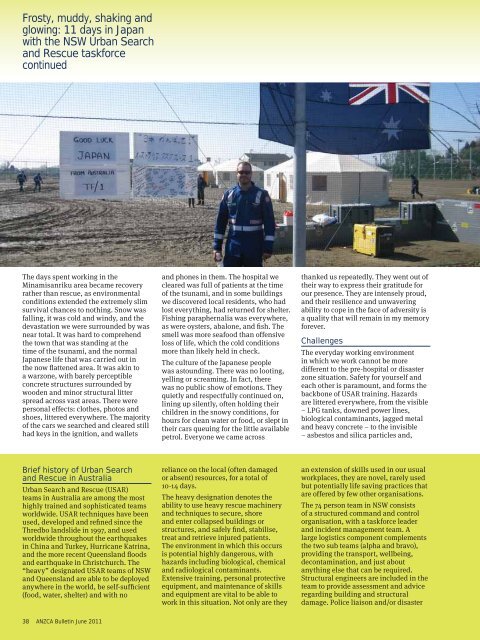ANZCA Bulletin June 2011 - Australian and New Zealand College of ...
ANZCA Bulletin June 2011 - Australian and New Zealand College of ...
ANZCA Bulletin June 2011 - Australian and New Zealand College of ...
You also want an ePaper? Increase the reach of your titles
YUMPU automatically turns print PDFs into web optimized ePapers that Google loves.
Frosty, muddy, shaking <strong>and</strong><br />
Heading glowing: 11 days in Sample<br />
Japan<br />
with the NSW Urban Search<br />
<strong>and</strong> Rescue taskforce<br />
continued<br />
The days spent working in the<br />
Minamisanriku area became recovery<br />
rather than rescue, as environmental<br />
conditions extended the extremely slim<br />
survival chances to nothing. Snow was<br />
falling, it was cold <strong>and</strong> windy, <strong>and</strong> the<br />
devastation we were surrounded by was<br />
near total. It was hard to comprehend<br />
the town that was st<strong>and</strong>ing at the<br />
time <strong>of</strong> the tsunami, <strong>and</strong> the normal<br />
Japanese life that was carried out in<br />
the now flattened area. It was akin to<br />
a warzone, with barely perceptible<br />
concrete structures surrounded by<br />
wooden <strong>and</strong> minor structural litter<br />
spread across vast areas. There were<br />
personal effects: clothes, photos <strong>and</strong><br />
shoes, littered everywhere. The majority<br />
<strong>of</strong> the cars we searched <strong>and</strong> cleared still<br />
had keys in the ignition, <strong>and</strong> wallets<br />
<strong>and</strong> phones in them. The hospital we<br />
cleared was full <strong>of</strong> patients at the time<br />
<strong>of</strong> the tsunami, <strong>and</strong> in some buildings<br />
we discovered local residents, who had<br />
lost everything, had returned for shelter.<br />
Fishing paraphernalia was everywhere,<br />
as were oysters, abalone, <strong>and</strong> fish. The<br />
smell was more seafood than <strong>of</strong>fensive<br />
loss <strong>of</strong> life, which the cold conditions<br />
more than likely held in check.<br />
The culture <strong>of</strong> the Japanese people<br />
was astounding. There was no looting,<br />
yelling or screaming. In fact, there<br />
was no public show <strong>of</strong> emotions. They<br />
quietly <strong>and</strong> respectfully continued on,<br />
lining up silently, <strong>of</strong>ten holding their<br />
children in the snowy conditions, for<br />
hours for clean water or food, or slept in<br />
their cars queuing for the little available<br />
petrol. Everyone we came across<br />
thanked us repeatedly. They went out <strong>of</strong><br />
their way to express their gratitude for<br />
our presence. They are intensely proud,<br />
<strong>and</strong> their resilience <strong>and</strong> unwavering<br />
ability to cope in the face <strong>of</strong> adversity is<br />
a quality that will remain in my memory<br />
forever.<br />
Challenges<br />
The everyday working environment<br />
in which we work cannot be more<br />
different to the pre-hospital or disaster<br />
zone situation. Safety for yourself <strong>and</strong><br />
each other is paramount, <strong>and</strong> forms the<br />
backbone <strong>of</strong> USAR training. Hazards<br />
are littered everywhere, from the visible<br />
– LPG tanks, downed power lines,<br />
biological contaminants, jagged metal<br />
<strong>and</strong> heavy concrete – to the invisible<br />
– asbestos <strong>and</strong> silica particles <strong>and</strong>,<br />
Brief history <strong>of</strong> Urban Search<br />
<strong>and</strong> Rescue in Australia<br />
Urban Search <strong>and</strong> Rescue (USAR)<br />
teams in Australia are among the most<br />
highly trained <strong>and</strong> sophisticated teams<br />
worldwide. USAR techniques have been<br />
used, developed <strong>and</strong> refined since the<br />
Thredbo l<strong>and</strong>slide in 1997, <strong>and</strong> used<br />
worldwide throughout the earthquakes<br />
in China <strong>and</strong> Turkey, Hurricane Katrina,<br />
<strong>and</strong> the more recent Queensl<strong>and</strong> floods<br />
<strong>and</strong> earthquake in Christchurch. The<br />
“heavy” designated USAR teams <strong>of</strong> NSW<br />
<strong>and</strong> Queensl<strong>and</strong> are able to be deployed<br />
anywhere in the world, be self-sufficient<br />
(food, water, shelter) <strong>and</strong> with no<br />
reliance on the local (<strong>of</strong>ten damaged<br />
or absent) resources, for a total <strong>of</strong><br />
10-14 days.<br />
The heavy designation denotes the<br />
ability to use heavy rescue machinery<br />
<strong>and</strong> techniques to secure, shore<br />
<strong>and</strong> enter collapsed buildings or<br />
structures, <strong>and</strong> safely find, stabilise,<br />
treat <strong>and</strong> retrieve injured patients.<br />
The environment in which this occurs<br />
is potential highly dangerous, with<br />
hazards including biological, chemical<br />
<strong>and</strong> radiological contaminants.<br />
Extensive training, personal protective<br />
equipment, <strong>and</strong> maintenance <strong>of</strong> skills<br />
<strong>and</strong> equipment are vital to be able to<br />
work in this situation. Not only are they<br />
an extension <strong>of</strong> skills used in our usual<br />
workplaces, they are novel, rarely used<br />
but potentially life saving practices that<br />
are <strong>of</strong>fered by few other organisations.<br />
The 74 person team in NSW consists<br />
<strong>of</strong> a structured comm<strong>and</strong> <strong>and</strong> control<br />
organisation, with a taskforce leader<br />
<strong>and</strong> incident management team. A<br />
large logistics component complements<br />
the two sub teams (alpha <strong>and</strong> bravo),<br />
providing the transport, wellbeing,<br />
decontamination, <strong>and</strong> just about<br />
anything else that can be required.<br />
Structural engineers are included in the<br />
team to provide assessment <strong>and</strong> advice<br />
regarding building <strong>and</strong> structural<br />
damage. Police liaison <strong>and</strong>/or disaster<br />
38 <strong>ANZCA</strong> <strong>Bulletin</strong> <strong>June</strong> <strong>2011</strong>

















